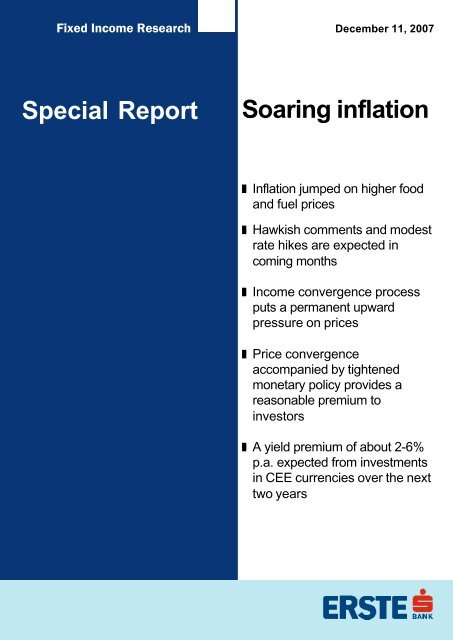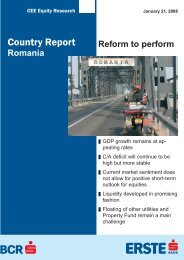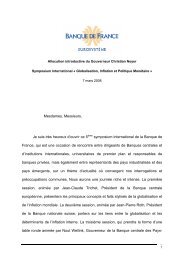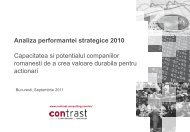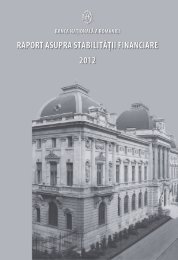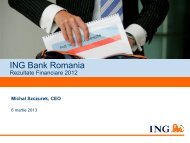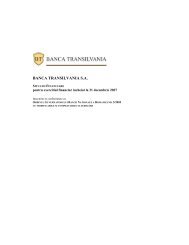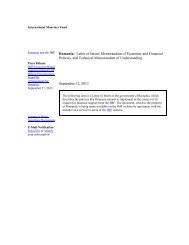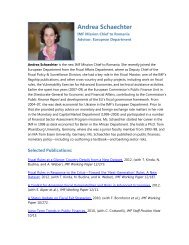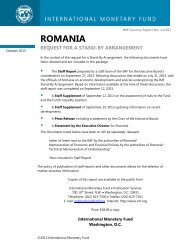Soaring inflation Special Report - Bancherul
Soaring inflation Special Report - Bancherul
Soaring inflation Special Report - Bancherul
- No tags were found...
You also want an ePaper? Increase the reach of your titles
YUMPU automatically turns print PDFs into web optimized ePapers that Google loves.
Fixed Income ResearchDecember 11, 2007<strong>Special</strong> <strong>Report</strong><strong>Soaring</strong> <strong>inflation</strong>❚ Inflation jumped on higher foodand fuel prices❚ Hawkish comments and modestrate hikes are expected incoming months❚ Income convergence processputs a permanent upwardpressure on prices❚ Price convergenceaccompanied by tightenedmonetary policy provides areasonable premium toinvestors❚ A yield premium of about 2-6%p.a. expected from investmentsin CEE currencies over the nexttwo years
<strong>Special</strong> <strong>Report</strong> December 11, 2007<strong>Soaring</strong> <strong>inflation</strong> - what does it mean for CEE 1) region?After a couple of years of a successful dis<strong>inflation</strong> process in CEE, <strong>inflation</strong> is suddenlyin an upward trend. This is not only a regional issue - <strong>inflation</strong> is growing worldwide. Itis mainly higher food and oil prices that are blamed for the higher <strong>inflation</strong> and theircontributions to <strong>inflation</strong> in CEE are much bigger than in Western of Europe. That is whywe decided in the first part of this report to look under the surface of the short-term factorsthat have elevated <strong>inflation</strong> in CEE in recent months. However, it is questionable whethercentral banks should react to one-off <strong>inflation</strong> factors, which are likely to have only atemporary effect on <strong>inflation</strong>; their origin is somewhere other than the local economy.In the second part of the report, we focus on price convergence associated withincome convergence, which puts pressure on price growth in the long run. A decentpart of the convergence has been achieved via exchange rate appreciation, whichincreased returns on investments in CEE fixed income instruments. The rest of theconvergence has been delivered via higher <strong>inflation</strong>, accompanied by higher interestrate differentials. Over 2000-07, investments in money market instruments of CEEcountries with flexible exchange rates generated 3-8% p.a. additional return aboveeuro money market investments.As CEE economies are to continue their price convergence process, investmentsin CEE countries with flexible exchange rates should continue to deliver premiumyields distributed differently among exchange rate appreciation and interest ratedifferentials. Demand for CEE currencies providing a yield premium should helpcentral banks in their dis<strong>inflation</strong> effort and skew the distribution of this premiummore towards exchange rate appreciation than to interest rate differentials.Short-term factors currently dominate in <strong>inflation</strong>Inflation jumped up byone percentage pointIn the last couple of months, the <strong>inflation</strong> development surprised on the upside almosteverywhere in Europe. Average <strong>inflation</strong> in the Eurozone suddenly jumped to 2.6% y/y in October from just 1.7% y/y reported two months ago (in August). A similardevelopment was observed in CEE economies, where <strong>inflation</strong> has increased aboutone percentage point or more 2) . This in not the whole story, as it is very likely that<strong>inflation</strong> in the Eurozone will climb further and approach 3% y/y in the coming months.Inflation development8%Aug-077%Oct-071)We analyzed only CEE countries with flexible exchange rates, particularly the Czech Republic, Slovakia, Hungary, Poland and Romania.2)Inflation in Hungary has not jumped because of a strong base effect from a year ago related to the change of VAT. However, them/m <strong>inflation</strong> of about 0.7-0.8% reported in September and October reveals the same pattern in growth of consumer prices.Page 26%5%4%3%2%1%0%Slovakia Euro zone Poland CzechRepublicSource: Eurostat, Erste Group ResearchRomaniaHungary
<strong>Special</strong> <strong>Report</strong> December 11, 2007One third of increasecan be ascribed to oilpricesIt is not difficult to find common determinants of the higher <strong>inflation</strong> in Europe. Thefirst is higher oil prices, which have been elevated from an average value of 60 USD/bbl in 1H07 to above 80 USD/bbl in October and further above 90 USD/bbl inNovember this year. While in the first half of this year, oil prices denominated in EURwere even about 10% lower than a year ago, oil prices increased tremendously - by28% y/y and 40% y/y in October and November, respectively. Higher oil pricesimmediately fed into fuel prices and increased <strong>inflation</strong> of transport costs by aboutthree percentage points, on average, as of October. Given the roughly 10-15% weightof transport costs in consumer baskets, higher oil prices explain about 0.3-0.4% ofthe recent upswing in <strong>inflation</strong>.Crude oil prices in USD/bbl10090807060504030201002004 2005 2006 2007Source: Reuters, Erste Group ResearchFood prices contributedmuch more to higher<strong>inflation</strong>Food prices have been the second factor behind the high <strong>inflation</strong>. Food prices in CEEeconomies went up 6-12% y/y in October, while in the Eurozone, it was "only" 3.9%y/y, on average. Given the weight of food prices in the consumer basket in the rangeof 17-20% for CEE and 36% for Romania, excessive food price growth (growth above<strong>inflation</strong>) contributed three percentage points to the recent <strong>inflation</strong> upswing inRomania and 0.6-0.8% for the rest of the CEE countries. In the table below, we cansee that it is mainly prices of bread and cereals, milk products and vegetables thathave increased remarkably. The price movement has been triggered by a killercombination - surging demand and squeezed supply caused by droughts (except forvegetable prices, where drought probably played the only role).Page 3
<strong>Special</strong> <strong>Report</strong> December 11, 2007Food <strong>inflation</strong> y/y by product categoriesEuro area 12Source: Eurostat, Erste Group ResearchCzechRepublicHungary Poland Romania SlovakiaOverall <strong>inflation</strong> 2.5 4.0 6.9 3.1 6.9 2.4Food prices y/y 3.9 6.7 13.5 6.0 10.3 6.6which of:Bread and cereals 5.4 6.9 22.5 10.8 11.8 15.9Meat 2.6 1.9 2.7 5.7 1.1 1.9Fish and seafood 2.2 1.0 5.0 1.7 1.7 1.9Milk, cheese and eggs 7.5 13.7 11.8 10.8 8.2 7.8Oils and fats 1.1 8.8 8.0 11.4 26.2 2.8Fruit 5.1 18.7 31.4 27.1 17.3 12.9Vegetables 3.3 3.5 30.0 -13.1 30.9 7.5Sugar and sweets 1.5 1.2 -1.6 -3.0 0.0 -1.3Food products n.e.c. 0.7 2.7 6.3 3.5 2.8 4.7Wheat prices doubled,due to drought andincreased demandWheat prices almost doubled during the year to 240 EUR/ton because of summerdrought and the shrinking surplus of wheat in the European market. Well-subsidizedEuropean producers used to struggle for many years with a surplus of production and"low prices". However, this has now been "resolved", thanks to increased demandfrom the bio-fuel industry, which is supported by generous tax incentives andsubsidized inputs.Wheat prices in EUR/ton350300250200150100500Jan-02 Jan-03 Jan-04 Jan-05 Jan-06 Jan-07Source: Reuters, Erste Group ResearchPage 4
<strong>Special</strong> <strong>Report</strong> December 11, 2007Shortage of milkpowder put pressure onmilk productsSeasonal and one-offeffects should not havebig influence on ratesHigher prices of milk products reflect rising demand for milk products and milkpowder, especially from the Asian market, where the growing affluent population ischanging its dairy consumption habits. Higher prices were also caused by supplyfactors. Drought in Australia, a big supplier of milk powder, contributed to a shortageof milk powder on the global market in the middle of year. Finally, higher wheat andcorn prices increased the price of feed, which pushed up production costs of milk.We should perhaps expect higher meat prices due to this effect soon.We believe that the supply, negatively affected by drought this year, will improve nextyear, or in the worst case stay at the current level. In both cases, the supply sideshould work for dis<strong>inflation</strong> next year. Because of the typical volatility of food and oilprices, central banks focus more on core <strong>inflation</strong> or <strong>inflation</strong> adjusted for fuel andfood prices. As shocks in food and fuel prices have been either exogenous and oneoffor seasonal, central banks do not automatically need to tighten monetary policydue to higher headline <strong>inflation</strong>. The same is valid for administrative measures likea hike of the VAT rate (as in Hungary in 2006 and the Czech Republic next year),which have sizable - but temporary - effects on <strong>inflation</strong>. On the other hand, if centralbanks do not form expectations firmly via some formal tightening, the credibility of<strong>inflation</strong> targeting may suffer and expectations of higher <strong>inflation</strong> can spill over intowages.Rationale behind further price convergenceApart from short-term factors, long-term price convergence also affects <strong>inflation</strong>,particularly when it comes to new EU member states. With goods and services stillcheaper than in the more advanced EU countries overall, new EU member states aregradually approaching price levels common for the EU-15. In order to achieveconvergence, the price growth is generally higher among the new member statesthan in 'old Europe' (the alternative channel of price convergence is exchange rateappreciation).Where does price convergence come from?Balassa-SamuelsoneffectPrice convergence comes alongside real convergence. This relationship is oftenexplained by the Balassa-Samuelson effect. The quicker economic growth in newEU member states (which are closing their productivity gaps against old EUcountries, particularly in the internationally competitive sector of tradable goods)translates into higher growth of wages, since companies distribute some of theirgains in employee earnings 3) . The wage growth in the tradable sector (spurred by theproductivity gains) transfers into salaries of workers in the area of services. Given thatthe service sector is not as open to cross-border competition, higher salaries can beachieved via higher prices of services and not only by productivity gains like in themore competitive tradable sector 4) .3)Increased demand for labor by new companies attracted by rising productivity also supports wage growth.4)Higher salaries also mean increased purchasing power and higher demand for goods and services.Page 5
<strong>Special</strong> <strong>Report</strong> December 11, 2007GDP in PPS vs. price level convergence paths90Czech RepublicHungaryEstoniaLatviaConvergencepath80LithuaniaSlovakiaPolandSloveniaPrice level706050403030 40 50 60 70 80 90GDP PPSSource: Eurostat, Erste Group ResearchQuality improvementsConvergence is moreadvanced in tradablegoods than in servicesUnfortunately, recent papers do not provide much evidence to explain priceconvergence through the B-S effect. The B-S effect has been reckoned between 1-2% p.a. for CEE countries 5) , only a fraction of the price convergence observed in newmember states during the last 10 years. Another aspect to be taken into considerationis the quality enhancements of goods and services in transition economies. Havingpreviously had lower purchasing power, producers in new EU members often focusedon offering low prices, sometimes at the expense of quality. As the income ofhouseholds in transition countries has grown, a higher share of producers started tooffer branded products at a higher price, but also with better quality. Hence, eventhough quality improvements support the statistical <strong>inflation</strong> rate, we believe thisprocess should not be viewed as harmful.Cross-country differences are much more profound for services than for goods. Thereason is that the cross-border trade is much easier in the case of tradable goods.For example, if the price of the same TV set was significantly different in twoneighboring countries, it would be relatively easy for retailers to import cheaperproducts in order to sell either at lower prices or with a higher margin. As aconsequence, demand for cheaper TV sets would grow at the expense of costly onesand their prices would gradually approach each other 6) . However, little such pressureexists in the case of services, as it is quite uncommon that people would go watcha movie in a neighboring country, even if the ticket price was much cheaper there 7) .5)See Egert B.: "Real Convergence, Price Level Convergence and Inflation Differential in Europe", WP138 - OeNB (2007)6)The prices do not necessarily have to be equal, since one has to count with transport costs when determining whether an importis more profitable than a domestic purchase. At the same time, a company in a cheaper country might have lower expenses, due todifferent input prices (such as wages, rent, taxes, etc.), allowing for some difference in prices even with a market equilibrium.7)There are exceptions in both groups. For example, prices of services offered online might be very competitive in many cases. Atthe same time, it might be difficult or too expensive to transport goods, which have short durability (such as bakery products), evenif the prices were significantly different.Page 6
<strong>Special</strong> <strong>Report</strong> December 11, 2007Growth of prices of tradable goods vs. services8%6%CE4 servicesEMU12 servicesCE4 tradable goodsEMU12 tradable goods4%2%0%-2%2002 2003 2004 2005 2006 2007The figure for CE4 is simple unweighted average of price growth rates in Czech Republic, Hungary,Poland and Slovakia. Source: Eurostat, Erste Group ResearchLargest price gapspersist in education,housing and healthcareIn 2005, the price level in the new EU member states varied between 42% and 89%of the EU average. In the case of services, the range was as wide as 25-81% of theEU average, while in the case of goods, the differences were shallower and the pricelevels were 57-92% of the EU average (in all mentioned categories, Bulgaria was thecheapest new EU member country, while Cyprus was the most expensive).Comparing 'old' and 'new' Europe, prices were particularly close in the cases ofclothing and communication, while the biggest existing price gaps are areas underpartial state control, such as education, housing (this category includes energyprices) and healthcare.Price levels by categoriesClothing0 20 40 60 80 100 120TransportationFood pricesHotels and restaurantsMiscHealthSource: Eurostat, Erste Group Research0 20 40 60 80 100 120GR, ESP,PTG (median) CEE including Baltics (median) CEE RangeAs a consequence, price growth is quicker in the case of services than in the caseof almost-converged tradable goods. This should also hold in the future, when higher<strong>inflation</strong> in emerging countries should be driven especially by prices of services. Thesituation is somewhat different in the case of those services still under stateinfluence, as regulators are able to put artificial brakes on price growth. PricePage 7
<strong>Special</strong> <strong>Report</strong> December 11, 2007convergence will come sooner or later in these sectors as well, but its pace willdepend on governments relaxing their regulatory grip.Exchange rate mattersPrice convergence does not automatically mean higher <strong>inflation</strong>. In countries withflexible exchange rate regimes, it is achieved by a mix of a positive <strong>inflation</strong>differential and currency appreciation. The more significantly the exchange ratestrengthens, the lower (even negative) the <strong>inflation</strong> differential is between thetransition country and the Eurozone. Currency appreciation significantly helpedsome CEE countries to compress <strong>inflation</strong> and progress in price convergence.Average contribution of exchange rate appreciation and <strong>inflation</strong> differentialto price convergence (p.a.)20%15%10%5%0%-5%-10%-15%Average exchange rate appreciation/depreciationAverage <strong>inflation</strong> differentialPoland Hungary CzechRepublicSlovakiaRomaniaSource: Eurostat, Erste Group ResearchInflation differentialabout 1-2% after joiningEurozoneFor a euro-adopting converging country, once the exchange rate is fixed, thedis<strong>inflation</strong>ary impact of exchange rate appreciation wanes and <strong>inflation</strong> is the onlychannel for price convergence 8) . As a consequence for euro hopefuls with a floatingexchange rate regime, <strong>inflation</strong> rates should accelerate after Eurozone entry -especially in those states where the gap in the price level is deeper. New EUmembers could also see precedents for higher <strong>inflation</strong> in some EU-15 countries,such as Portugal, Greece and Spain. These three cheapest EU members among 'oldEurope' countries all saw higher <strong>inflation</strong> than the rest of the EU-15 countries.Compared to EU-15 average <strong>inflation</strong> at 2.0% y/y in 1999-2006, price growth in allmentioned countries exceeded 3% in the same period. A unique case is Ireland,which is no longer an economic laggard in the EU-15, as it was in the 1980s. However,Ireland's strong economic growth, which continuously exceeded other EU-15countries in the last couple of years, also brought higher <strong>inflation</strong> (at 3.5% y/y onaverage during 1999-2006). Given the much lower price level in CEE, the <strong>inflation</strong>differential of CEE after fixing currencies might be higher than in Ireland, approaching2% or even higher, on average.8)The euro exchange rate could still fluctuate against the currencies of the country's trading partners outside the Eurozone, in turninfluencing imported <strong>inflation</strong>.Page 8
<strong>Special</strong> <strong>Report</strong> December 11, 2007Investments in CEE currencies benefit from price convergencePrice convergence isaccompanied bymonetary tightening…To combat higher <strong>inflation</strong>, the new EU member states will have to tighten monetaryconditions. This should particularly concern euro adepts ahead of evaluation of theirpreparedness to adopt the euro, as the Maastricht criteria do not take long termconvergence much into account. Hence, even more tightening is necessary tocompress <strong>inflation</strong> to below the required limit. Tightening might take the form of anappreciating currency or via central bank rate hikes. We see the currency route asthe more efficient with regards to <strong>inflation</strong>, especially as new EU members generallybelong to the most open economies within the EU 9) and the exchange rate has a moresignificant impact on <strong>inflation</strong> than in some bigger 'old Europe' economies. What ismore, if one believes that the domestic currency will not depreciate 10) , high domesticinterest rates might be circumvented by borrowing in a foreign currency.An average yield premium (p.a.)16%14%2000-2007 2004-20072005-2007 2006-200712%10%8%6%4%2%0%Czech Rep Hungary Slovakia Poland RomaniaSource: Reuters, Erste Group Research…which providesgenerous yieldpremiums to currencyinvestorsAs a result of tightening via exchange rate appreciation or increased interest ratedifferential, investors with funding in euro receive a premium yield for investments inCEE currencies. The yield might be volatile, but in general it provides a reasonablepremium. Over 2000-07, investments in money market instruments in CEE countrieswith flexible exchange rates generated 3-12% p.a. additional return above euromoney market investments.As long as countries converge in terms of income and price levels, we expect thispremium to stay positive in countries with a flexible exchange rate regime and<strong>inflation</strong> targeting. According to our forecasts, the highest yield premium over 2008-09, about 6% p.a. including interest rate carry, could be achieved via investments inthe Romanian leu, followed by a yield premium of 3.6% p.a. for the Polish zloty.Investments in the Czech koruna should produce a yield premium of about 2.5% p.a.on average during 2008-09. About a 2% p.a. yield premium is expected for Hungary,where slow economic growth provides only modest impetus for price convergenceand rationale for tight monetary policy. We expect a yield premium for investmentsin the Slovak koruna of close to zero on average over 2008-09, as the exchange ratewill be fixed and rates aligned with the Eurozone soon, due to euro adoption.9)Larger countries such as Romania and Poland are exceptions, being around the EU average.10)This is not an unreasonable assumption in new EU member states with a floating regime, due to higher productivity growth.Page 9
<strong>Special</strong> <strong>Report</strong> December 11, 2007Expected <strong>inflation</strong> and average yield premium p.a. for 2008-09Inflation2007 2008 2009Interest ratedifferentialCurrency appreciation p.a.Yieldpremium p.a.CZECH REPUBLIC 4.0 5.1 3.2 -0.3 2.8 2.5SLOVAKIA 3.3 3.5 3.5 0.0 0.0 0.0HUNGARY 6.9 3.9 2.3 2.1 0.0 2.1POLAND 3.4 3.0 2.7 1.2 2.4 3.6ROMANIA 6.1 4.8 4.2 3.4 2.9 6.2Source: Erste Group ResearchConclusionHigher commodity prices, particularly of crude oil, wheat and milk powder, have beencrucial factors that have elevated <strong>inflation</strong> in recent months. While growing globaldemand for wheat and milk powder could continue to put pressure on prices, thesupply side should work in the opposite direction, unless droughts occur again nextyear. We expect that central banks will not fully respond to these factors, as theyare exogenous and very likely to only have temporary or one-off effects on <strong>inflation</strong>.However, some reaction by the CEE central banks is still likely, and we expect themto respond to higher headline <strong>inflation</strong> with modest rate hikes or at least by makinghawkish comments to further their dis<strong>inflation</strong>ary efforts.However, for future price development and profitability of investments in CEEcurrencies, the convergence story related to growth of incomes and price levels ismore important. CEE countries continue to grow in income and their price levels arealso rising because of more expensive services and price growth related to qualityimprovements. Price convergence in CEE is achieved via a combination of exchangerate appreciation and <strong>inflation</strong> differentials, which are both supportive for investmentsin CEE currencies. The <strong>inflation</strong> differential translates into a higher interest ratedifferential, while exchange rate appreciation increases the return on currencyinvestments directly. Further price convergence and tightened monetary conditionsin CEE (via exchange rate appreciation or/and higher interest rates) should generatea yield premium on investments in CEE currencies of about 2-6% p.a. over the nexttwo years. The exception is Slovakia, where monetary policy will not have anopportunity to react to price convergence because of the expected euro adoption.Juraj Kotian, co-Head CEE Macro & Fixed Income Research - Erste Group ResearchJuraj.Kotian@erstebank.atMichal Mušák, Senior analyst - Slovenská sporitelnaMusak.Michal@slsp.skPage 10
<strong>Special</strong> <strong>Report</strong> December 11, 2007Comments to <strong>inflation</strong> outlook and exchange rate/interest rate developmentCzech Republic – David Navratil (macro analyst at Ceska sporitelna): Inflationwill accelerate to 6% due to supply-side factors: foodstuff, oil prices and regulatedprices plus change in taxes, while the demand <strong>inflation</strong> is still compressed deepbelow the <strong>inflation</strong> target. CZK is currently the strong, however, the trend reversalshould come in 1H as koruna will come back to EUR/CZK 27-27.3. Inflation structureand CZK will limit speed of rate hikes, therefore we expect another hike in April andat the end-2008 to 3.75-4%.Hungary - Orsolya Nyeste (macro analyst at EB Hungary): While in the regionalcountries free floating systems operate which allow nominal currency appreciation,in Hungary the central bank is not totally independent in its tools fighting against<strong>inflation</strong>, as in the range 240-245 HUF/EUR it should rather concentrate on defendingthe exchange rate band than <strong>inflation</strong> fighting. Such a system keeps <strong>inflation</strong> andinterest rates nominally higher - compared to the Czech Rep. Slovakia and Poland.However, given subdued economic growth in Hungary and supposing anchored<strong>inflation</strong>ary expectations, no significant second-round <strong>inflation</strong> effects and improvementin the global market environment, the central bank could cut the base rate to 7% byJune 2008 and to 6.50% by the end of next year.Slovakia – Michal Musak (macro analyst at Slovenska sporitelna): In Slovakia,the planned 2009 Emu entry means that the koruna will be replaced by the euro andinterest rates will be the same as in the remaining EMU countries. While continuedprice convergence will likely lead to higher <strong>inflation</strong> compared to the Eurozone, themonetary policy will be shared with the Eurozone. In case of the less likely scenarioof euro delay, the first response would likely be significant currency depreciation.Still, from the medium-term perspective, convergence would lead to renewedcurrency strengthening after this initial weakening period.Poland – Martin Lobotka (macro analyst at Ceska sporitelna): Inflation is on therise as elsewhere in the CEE region, the main factors driving it are food and fuel. Thesituation in Poland is more complicated than in other countries in terms of translationof the higher headline <strong>inflation</strong> into expectations. While the Slovak Republic enjoyshealthy and high growth with real wages still far from growth of real productivity,Hungary is dis<strong>inflation</strong>ary in terms of the real economy (if not <strong>inflation</strong>ary expectationsbuildup). The Czech Republic is in a similar situation as Poland, but lower GDPgrowth next year due to reforms, moderate unions’ demands and lower consumptionmakes the threat of <strong>inflation</strong>ary expectations buildup more remote than in aneconomy such as the Polish where aggregate real wages grow at double-digit ratesand nothing is in sight to slow the economy. Therefore, the MPC will need to deliverat least two hikes next year to contain this threat.Romania – Dumitru Dulgheru (macro analyst at BCR): The central bank is setto tighten monetary policy in 2008, particularly in the first half of the year, when thekey rate could be raised by 50 bp to 8%. This is to ensure an improved outlook of<strong>inflation</strong> in the medium term, while mandatory reserves which are the highest in theEU are likely to remain at this level. In the medium term, RON is expected toappreciate, amidst higher volatility during some periods generated by internationaland local developments. An attractive interest differential as compared to peercountries along with fairly good economic performance of the country in the yearsahead, including limitation of the external imbalance, and a more stable internationalcontext should restore confidence towards the region and in the Romanian marketin particular with favourable effects on the FX rate.Page 11
<strong>Special</strong> <strong>Report</strong> December 11, 2007Published by Erste Bank der oesterreichischen Sparkassen AG Neutorgasse 17, OE 543 A-1010Vienna, Austria. Tel. +43 (0)50100-ext.Erste Bank Homepage: www.erstebank.at On Bloomberg please type: ERBK .This research report was prepared by Erste Bank der oesterreichischen Sparkassen AG (”Erste Bank”) or its affiliate named herein. The informationherein has been obtained from, and any opinions herein are based upon, sources believed reliable, but we do not represent that it is accurateor complete and it should not be relied upon as such. All opinions, forecasts and estimates herein reflect our judgement on the date of this reportand are subject to change without notice. The report is not intended to be an offer, or the solicitation of any offer, to buy or sell the securities referredto herein. From time to time, Erste Bank or its affiliates or the principals or employees of Erste Bank or its affiliates may have a position in thesecurities referred to herein or hold options, warrants or rights with respect thereto or other securities of such issuers and may make a marketor otherwise act as principal in transactions in any of these securities. Erste Bank or its affiliates or the principals or employees of Erste Bankor its affiliates may from time to time provide investment banking or consulting services to or serve as a director of a company being reported onherein. Further information on the securities referred to herein may be obtained from Erste Bank upon request. Past performance is not necessarilyindicative for future results and transactions in securities, options or futures can be considered risky. Not all transaction are suitable for everyinvestor. Investors should consult their advisor, to make sure that the planned investment fits into their needs and preferences and that the involvedrisks are fully understood. This document may not be reproduced, distributed or published without the prior consent of Erste Bank. Erste Bankder oesterreichischen Sparkassen AG confirms that it has approved any investment advertisements contained in this material. Erste Bank deroesterreichischen Sparkassen AG is regulated by the Financial Services Authority for the conduct of investment business in the UK.Please refer to www.erstebank.at for the current list of specific disclosures and the breakdown of Erste Bank’s investment recommendations.Page 12
ContactsGroup ResearchHead of Group ResearchFriedrich Mostböck, CEFA +43 (0)50 100-11902CEE Equity ResearchCo-Head: Günther Artner, CFA +43 (0)50 100-11523Co-Head: Henning Eßkuchen +43 (0)50 100-19634Günter Hohberger (Banks) +43 (0)50 100-17354Franz Hörl, CFA (Steel, Construction) +43 (0)50 100-18506Gernot Jany (Banks, Real Estate) +43 (0)50 100-11903Daniel Lion (IT) +43 (0)50 100-17420Martina Valenta, MBA (Transp., Paper) +43 (0)50 100-11913Christoph Schultes (Insurance, Utilities) +43 (0)50 100-16314Vera Sutedja, CFA (Telecom) +43 (0)50 100-11905Vladimira Urbankova (Pharma) +4202 24 995 940Gerald Walek, CFA (Machinery) +43 (0)50 100-16360International EquitiesHans Engel (Market strategist) +43 (0)50 100-19835Ronald Stöferle (Asia) +43 (0)50 100-11723Jürgen Rene Ulamec, CEFA (Europe) +43 (0)50 100-16574Macro/Fixed Income ResearchHead: Veronika Lammer (Euroland,SW) +43 (0)50 100-11909Alihan Karadagoglu (Corporates) +43 (0)50 100-19633Rainer Singer (US, Japan) +43 (0)50 100-11185Elena Statelov, CIIA (Corporates) +43 (0)50 100-19641Macro/Fixed Income Research CEECo-Head CEE: Juraj Kotian (Macro/FI) +43 (0)50 100-17357Co-Head CEE: Rainer Singer (Macro/FI) +43 (0)50 100-11185Editor Research CEEBrett Aarons +420 224 995 904Research, Croatia/SerbiaHead:Mladen Dodig +381 11 22 00 866Damir Cukman (Equity) +385 62 37 28 12Ivan Gojnic (Equity) +381 11 22 00 852Alen Kovac (Fixed income) +385 62 37 13 83Uros Mladenovic (Equity) +381 11 22 00 872Davor Spoljar (Equity) +385 (62) 372 825Research, Czech RepublicHead: Viktor Kotlan (Fixed income) +420 224 995-217Petr Bartek (Equity) +420 224 995 227Maria Hermanova (Fixed income) +420 224 995 232Jan Hajek, CFA (Equity) +420 224 995 324Radim Kramule (Equity) +420 224 995 213Martin Lobotka (Fixed income) +420 224 995 192Lubos Mokras (Fixed income) +420 224 995 456David Navratil (Fixed income) +420 224 995 439Jakub Zidon (Equity) +420 224 995 340Research, HungaryHead: József Miró (Equity) +361 235-5131György Zalányi (Equity) +361-235-5135Orsolya Nyeste (Fixed income) +361 373-2830Research, PolandHead: Artur Iwanski (Equity) +48 22 3306253Magda Jagodzinska (Equity) +48 22 3306250Marcelina Hawryluk (Equity) +48 22 3306255Tomasz Kasowicz (Equity) +48 22 3306251Piotr Lopaciuk (Equity) +48 22 3306252Marek Czachor (Equity) +48 22 3306254Research, RomaniaHead: Lucian Claudiu Anghel +4021 312 6773Treasury - Erste Bank ViennaSales Retail & SparkassenHead: Manfred Neuwirth +43 (0)50100-84250Equity Retail SalesHead: Kurt Gerhold +43 (0)50100-84232Domestic Sales Fixed IncomeHead: Thomas Schaufler +43 (0)50100-84225Treasury Domestic SalesHead: Gottfried Huscava +43 (0)50100-84130Corporate DeskHead: Leopold Sokolicek +43 (0)50100-84601Alexandra Blach +43 (0)50100-84141<strong>Special</strong> <strong>Report</strong> December 11, 2007Mihai Caruntu (Equity) +4021 311 27 54Dumitru Dulgheru (Fixed income) +4021 312 6773 1028Cristian Mladin (Fixed income) +4021 312 6773 1028Loredana Oancea (Equity) +4021 311 27 54Raluca Ungureanu (Equity) +4021 311 27 54Research, SlovakiaHead: Juraj Barta (Fixed income) +421 2 59 57 4166Michal Musak (Fixed income) +421 2 59 57 4512Maria Valachyova (Fixed income) +421 2 59 57 4185Institutional SalesHead of Sales Equities & DerivativesMichal Rizek +4420 7623-4154Brigitte Zeitlberger-Schmid +43 (0)50 100-83123Equity Sales Vienna XETRA & CEEHind Al Jassani +43 (0)50 100-83111Werner Fuerst +43 (0)50 100-83114Josef Kerekes +43 (0)50 100-83125Ana Milatovic +43 (0)50 100-83131Stefan Raidl +43 (0)50 100-83113Simone Rentschler +43 (0)50 100-83124Sales DerivativesChristian Luig +43 (0)50 100-83181Manuel Kessler +43 (0)50 100-83182Sabine Kircher +43 (0)50 100-83161Christian Klikovich +43 (0)50 100-83162Armin Pfingstl +43 (0)50 100-83171Roman Rafeiner +43 (0)50 100-83172Equity Sales, LondonDieter Benesch +4420 7623-4154Tatyana Dachyshyn +4420 7623 4154Jarek Dudko, CFA +4420 7623 4154Federica Gessi-Castelli +4420 7623-4154Declan Wooloughan +4420 7623-4154Sales, CroatiaZeljka Kajkut (Equity) +385 62 37 28 11Damir Eror (Equity) +385 62 37 28 13Sales, Czech RepublicMichal Brezna (Equity) +420 224 995-523Ondrej Cech (Fixed income) +420 224 995-577Michal Rizek +420 2 2499 5537Jiri Smehlik (Equity) +420 224 995-510Pavel Zdichynec (Fixed income) +420 224 995-590Sales, HungaryRóbert Barlai (Fixed income) +361 235-5844Gregor Glatzer (Equity) +361 235-5144Krisztián Kandik (Equity) +361 235-5140Zoltán Szabó (Fixed income) +361 235-5144Sales, PolandHead: Andrzej Tabor +4822 330 62 03Pawel Czuprynski (Equity) +4822 330 62 12Lukasz Mitan (Equity) +4822 330 62 13Jacek Krysinski (Equity) +4822 330 62 18Sales, SlovakiaHead: Dusan Svitek +421 2 5050-5620Rado Stopiak (Derivatives) +421 2 5050-5601Andrea Slesarova (Client sales) +421 2 5050-5629Roman Friesacher +43 (0)50100-84143Helmut Kirchner +43 (0)50100-84144Christian Skopek +43 (0)50100-84146Fixed Income Institutional DeskHead: Thomas Almen +43 (0)50100-84323Martina Fux +43 (0)50100-84113Michael Konczer +43 (0)50100-84121Ingo Lusch +43 (0)50100-84111Ulrich Inhofner +43 (0)50100-84324Karin Rauscher +43 (0)50100-84112Michael Schmotz +43 (0)50100-84114Page 13


